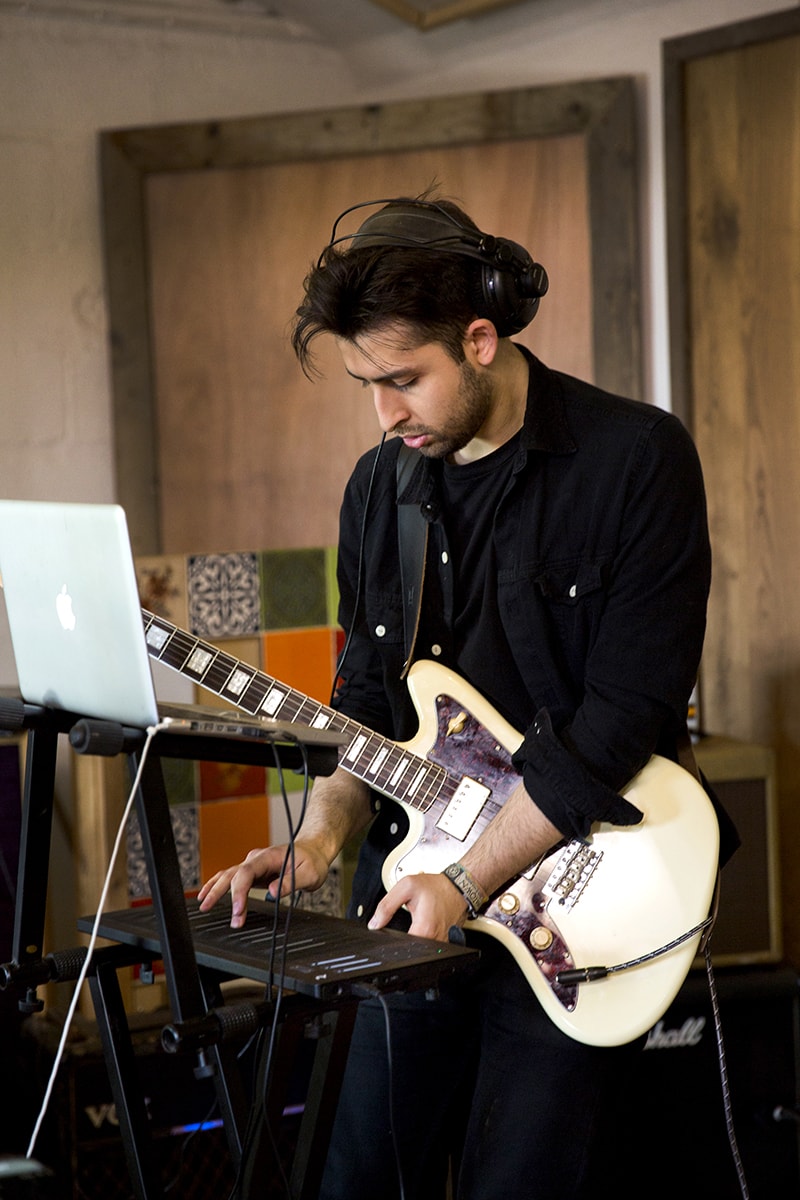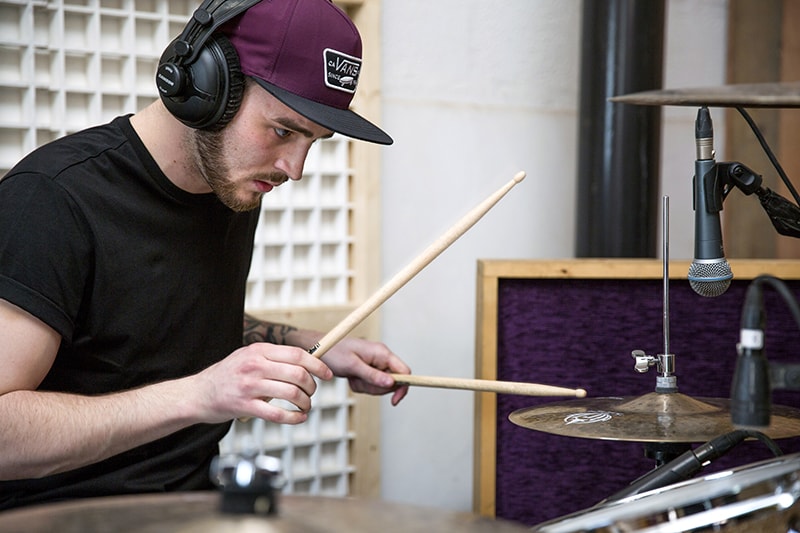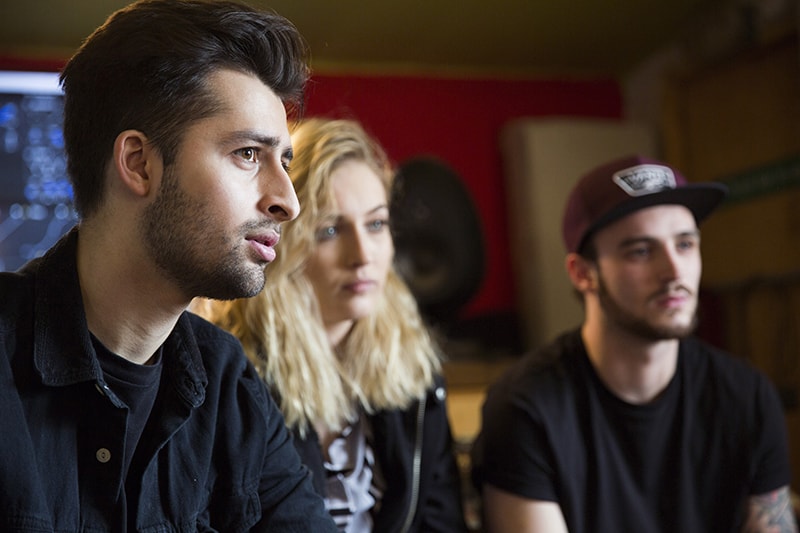On the RISE: Finding their Sound with Polar Front
Indie pop-rockers from Swindon, UK

“It’s an amazing feeling when you lock in a sound,” says Liam O’Halloran, drummer in the British band Polar Front. “It’s like, ‘That’s the sound we were missing from the track! This is it. Let’s sit down and forget everything else for now. Because if we can lock in this sound in to the melody and decide this is where we’re going, the rest will come.’”
That feeling came to Liam and his bandmates when they discovered some of the bass sounds on the Seaboard RISE 49. These sounds changed how they composed “Eye to Eye“, their new single, darkening the song’s mood and adding weight and texture that make it seem an altogether larger undertaking than a three-piece band working in an unheated studio down a farm road outside Swindon, England.
Polar Front is a band looking to lock in a sound — and not just for an individual track. The three members, all 22 years old, came together in June 2015, and they’re naturally still finding their groove. Their sound is also fundamentally eclectic. When Polar Front gigs around Swindon, their fans can’t always put their finger on a sound with moments of blues, rock, and funk.
“Someone called it ‘cinematic indie,’ which I love,” said Perry Sangha, the band’s guitarist.
“We get a lot of combinations,” said Liam. “I heard recently we’re ‘Adele with Chris Isaacs.’”
“I heard Lana del Ray with Fleetwood Mac,” Perry said. “The sound’s atmospheric – but still with live drums.”
“There’s definitely an element of rock,” agreed Sophie Rose Goldsworthy, singer and keyboardist. “It’s because Liam’s grown up drumming in heavy metal bands. And Perry’s good with funk and soul and bluesy riffs. I’m a classically trained pianist, and I grew up listening to Adele and the big female vocalists. I’ve sung opera, I’ve sung pop. So together we take bits from all these genres and we make it our own.”

“Eye to Eye“ started off like all of their songs do: with a chord or lyrical phrase touching off a frenzy of feedback – including over group chats at all hours of the night – about how to flesh it out and make it music.
“It started with a guitar riff, and that riff became the bassline,” said Perry. “It started off jazzy. I was picturing a bluesy American venue after dark where you shouldn’t go. At first it was pure soul R&B with no ambient aspect to it.”
He said to Sophie, “You pretty much nailed down the vocals instantly.”
“If I hear Perry’s chords I’ll do Oh’s and Ah’s and La’s to get the melody, and then I’ll write the words,” said Sophie. “That’s how I got the first note in the song. I was sliding between notes to see where the chord was going next, and the slide worked.” The lyrics, she said, “sort of came out of nowhere:” You say you want me, you need me / Everything you’ve dreamed but / I ain’t playing around / You know you have me completely / You can even keep me but / I ain’t playing around.

“This is how our writing works,” said Liam. “One of us has a riff or an idea, and we all have ideas in our heads of how it’s going to sound. Sophie or Perry is sitting by the computer, all itching to get it out, and I’m outside having a cup of tea, and I rush back in and say, ‘Perry, wait! Let’s change that!’ Because we’re so excited about it, it all kind of comes out at once.”
“Eye to Eye“ went from guitar riff to song in short order. But it was too jazzy to fit with the other songs in their set, and time was counting down until their next live show. That was when the band’s Seaboard RISE 25 arrived.
“We sat in Perry’s room,” said Sophie. “The Seaboard was all shiny and new. We were thinking, ‘What can we do with it?’ And we literally completed the whole song in a few hours using the sounds on the Seaboard. It took the sound from jazz and soul to something that still had that jazz feel to it but was more spacey, synthy.”

“For me, it was that first sound setting on the Seaboard that really did it,” said Perry. “It isn’t even a preset. It’s a pure sine wave. But it was this amazing, warm bass sound. And you can tell this is going to push the whole song into a different groove. You cycle through the sounds, and they encourage you to go in different directions. The double bass sound is so expressive it’s almost telling you the next note. You’re pushing into it, and it’s sending something back to you. And it gave a real swing to the song … The Seaboard was pretty essential to “Eye to Eye“.”
Polar Front added new layers of bass, string, and electronic sounds to complement Perry’s electric guitar, Sophie’s voice, and Liam’s drums. They fine-tuned the sounds with reverb, delay, and other effects in Equator. Now when they perform the song live, Sophie and Perry both have a Seaboard in front of them. Right from the beginning, Sophie shapes synthetic sounds that build up to her vocal opening: Oh, why are you so shy? / Didn’t anybody teach you / About eye to eye?
The RISE does not give Polar Front a sound in the way that a banjo makes a folk band. It expands the moods that the band write into their music. And that is what the three bandmates want from it. Their music, they say, is about creating an overall feeling that has more to do with mood than with words or melodies.
“We’d love it for people in the crowd to be singing the song for the lyrics and stuff, but for us it’s more about projecting a feeling,” said Liam. “We want music that takes you over. After the show we’re always wondering how it felt for other people.”

“With the Seaboard and all our instruments, we take the bits of sounds that relate to the feelings we’re trying to portray,” said Sophie. “An acoustic guitar makes you think of summer and driving with the windows down. Strings in a horror movie make you know something bad is about to happen. And just by having this controller with the endless sounds you can create, it makes it so much easier to portray the feelings you’re looking for. Maybe you want an orchestra. And you can literally play an orchestra on a few keys.”
Their songwriting starts with those kernels of feelings captured in a haunting chord or a three-word phrase. The RISE is now giving up those kernels by itself, Perry says. “With the Seaboard, you’re working with sounds in a few ways,” he said. “It can give you that final touch to your song that puts it in the right place. But you can also find a sound on it, and the whole idea of a song comes from that sound when you first hit the note. You suddenly see the words on the paper, the pictures in the movie, all from one sound.”
Liam describes the RISE as a fourth member of the band, which is accurate in some senses. It lets Sophie back up Perry on bass – which she plays on the Seaboard.
undefined
We literally completed the whole song in a few hours using the sounds on the Seaboard

“I can play bass guitar, but I can’t play bass and sing at the same time, because the rhythm throws me off,” Sophie said. “So we’ve had a few people step in and play bass. Because I play piano, it’s so much easier for me to put the bass sound on the Seaboard and play it that way. For some reason pressing into the surface helps me with the rhythm. So it gives us that fuller sound, that big-band sound we were lacking before, and we can stay a three-piece band without having to bring anyone else in.”
June will mark Polar Front’s first full year. They are becoming a hot ticket in Swindon, where the bandmates were born and raised. But they’re open to moving on, and they hope their unusual sound – a mixture of elements from far beyond the west of England – gets them there.
“We definitely have the California dream in our head,” Liam said. “We feel like there’s way more opportunity out there. We just want to be in a land where people say, ‘Who are these people?’ Because we’re from a different place and have a different sound than what they’ve heard before.”
Join the ROLI community